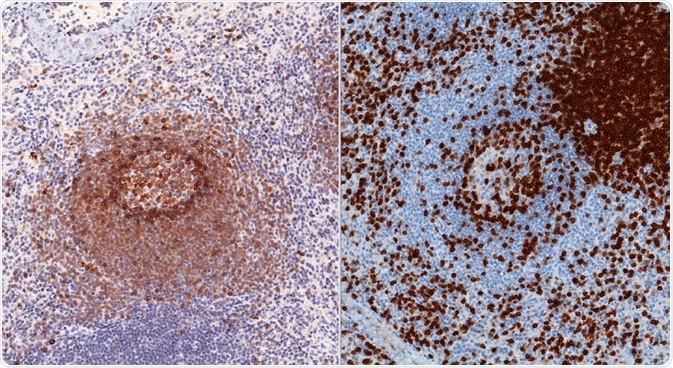Immunohistochemistry (IHC) is a technique that allows researchers to visualize the spatial distribution of cellular components within the tissue architecture. Enzymatic immunohistochemistry is one of the detection methods that can be used when considering IHC approaches.

vetpathologist | Shutterstock
Development of enzymatic immunohistochemistry
The enzymatic technique was developed in the 1960s, approximately 20 years after the traditional immunofluorescence method had been developed. While immunofluorescence methods are well established and can be applied to more than one target, they have several drawbacks. These include; the deterioration of the fluorescent signal when excited and stored, autofluorescence of the surrounding tissue, and a limited number of color combinations.
Rather than focusing on a fluorochrome (like fluorescence methods do), enzymatic IHC works by an enzyme label reacting with a substrate to produce a colored product, which is then detected and visualized.
Benefits of enzymatic IHC
Enzymatic IHC solves some of the problems presented by fluorescent IHC because stained samples can be stored for a longer period of time and reduced autofluorescence because a simple light microscope (rather than a fluorescence microscope) can be used. Alternatively, an electron microscope can be used.
Further benefits offered by enzymatic IHC that are missed by immunofluorescence IHC include higher accuracy when determining antigen location due to better contrast ratio, as well as the ability of certain counterstains (such as hematoxylin) which enhance tissue architecture visibility. Like fluorescence IHC, enzymatic IHC can also be implemented with two or more stains to distinguish several target cellular components.
IHC in general is widely used for diagnostic purposes, and enzymatic IHC is no different. Enzymatic IHC (such as unlabeled antibody methods) has also been applied to renal immunohistochemistry, while direct enzymatic IHC has an important use for lymphoproliferative diseases, and for the study of the endocrine system.
How does enzymatic immunohistochemistry work?
In a nutshell, enzymatic IHC involves an enzymatic reaction between the antibody and the antigen. The antibody is labeled with an enzyme prior to reacting with the antigen. Once they have reacted, the labeled antigen creates a complex with the antibody, wherein the enzyme catalyzes a reaction to create an insoluble colored product from a substrate. It is this reaction product which is analyzed using a light or electron microscope.
There are direct and indirect methods to carry out enzymatic IHC. In the direct method, a labeled antibody directly reacts with the target antigen, and this complex then reacts with a diaminobenzidine (DAB) substrate to produce the colored stain. The direct method has been commonly applied when monoclonal antibodies are screened prior to large scale manufacturing processes.
The indirect method has two separate steps. In the first step, an antibody which is not labeled binds to the desired antigen. The second step involves a secondary antibody that is labelled with an enzyme reacting with the primary antibody.
The secondary antibody in question has to be raised against the immunoglobulin G (IgG), or antibody, in which the primary antibody was raised. For example, with a primary antibody being rabbit anti-human IgG, the secondary antibody with the enzymatic label would be goat anti-rabbit IgG.
The direct method is simpler and quicker than the indirect method. While it has high specificity, its sensitivity is lower than indirect detection, and has a constrained number of primary antibodies that can be directly labeled. Furthermore, a relatively small amount of labeled secondary antibody are needed for the indirect method compared to the direct method.
More specifically, the direct method would necessitate labeling of each primary antibody for every target antigen, whereas with the indirect method, it is also possible to design and apply several types of controls to broaden experimental potential.
There are also unlabeled antibody methods. The enzyme bridge method is one such method, wherein an enzyme label binds to a target antigen via the reaction between the antigen and antibody of an immunoglobulin enzyme bridge.
The peroxidase-anti-peroxidase (PAP) method exploits the immunization of an antibody with a horseradish peroxidase moiety to create an anti-horseradish peroxidase antibody, which is in turn capable of binding to another horseradish peroxidase moiety to produce a stable polygon.
Last Updated: Jan 3, 2019